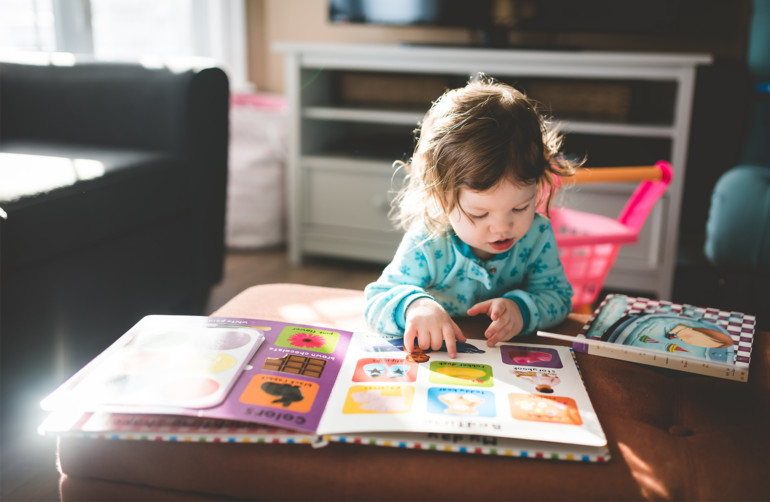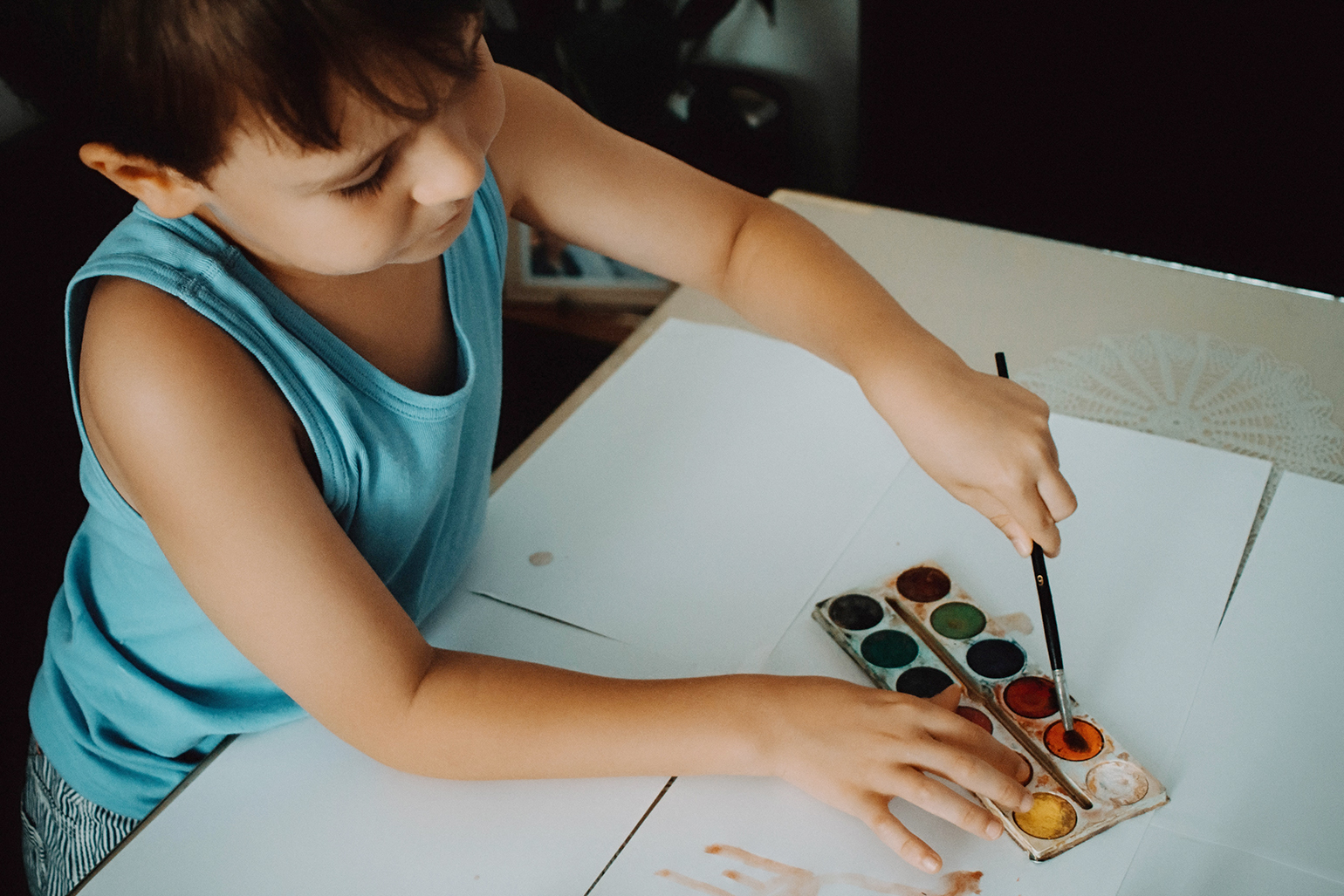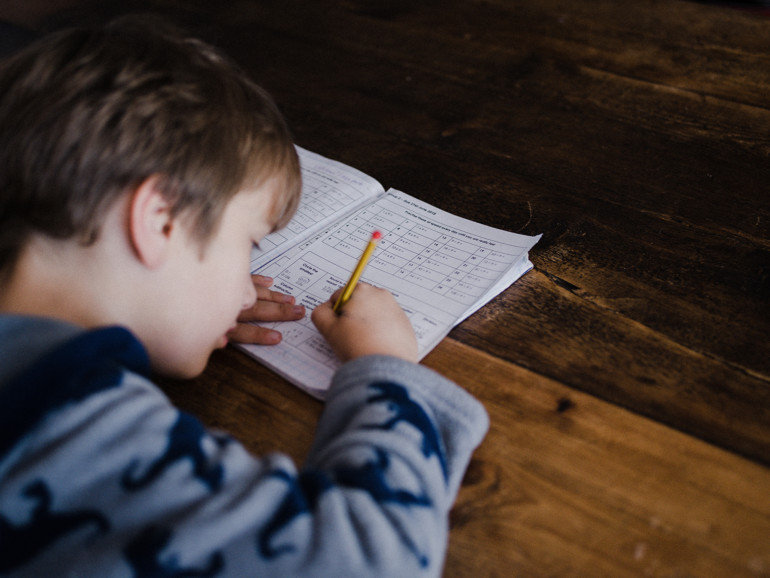COVID-19 has forced widespread school closures, requiring students of all ages to make the unprecedented pivot to distance learning. Now, parents across the country are suddenly grappling with the fact that they have to be in charge of their child’s education, in addition to normal work and home responsibilities.
The result? A lot of panic, a lot of screen time, a lot of crying (from parents even more than their kids). Distance learning is definitely a challenge, and keeping kids engaged at home can feel like an insurmountable task, especially when you’ve been tied up on conference calls all morning and the kids have reached their daily limit on Disney+. That’s why a panel of teachers — from Pre-K all the way through high school — is here with our best tips for online education. We miss our students a lot, but probably not as much as parents miss us.

For Preschool and Kindergarten:
The main takeaway is routine, routine, routine. And also patience, patience, patience. “The biggest thing is parents trying to keep a structured schedule for their kids at home,” says Lauren Braverman, who teaches Early Childhood Special Education. “Get them up at the same time, get them dressed, have breakfast, whenever possible.” We know that you’re all working from home too and sometimes schedules can be difficult, but any sort of structure is crucial to development at this age.
Additionally, Arielle Shanker, who also teaches pre-kindergarten, says utilizing timers throughout the day can be extremely helpful in warding off tantrums that can come with transition times (i.e. bedtime, clean-up time, etc.) “Timers eliminate a lot of the power struggle that tends to happen around these times,” Shanker says. “With the timer going off, it takes the personal out of the equation. Teachers often utilize these in the classroom too, so students should be comfortable with this routine.”
That being said, parents shouldn’t feel the need to fill every waking hour with academic stimuli. “I see no problem in letting kids be BORED,” Shanker says. “In a lot of cases, that boredom fuels creativity and promotes the development of independent problem-solving skills in students.”
When it is time for concrete learning, however, Braverman recommends Epic! Books, an online digital library for kids that has read-aloud and “read to me” options. Vooks (free 30-day trial) and Starfall, “are really good for early learning resources,” Braverman says. “[They have] literacy and math and nursery rhymes which kids need to be working on for reading.” Shanker likes Cosmic Kids Yoga on YouTube and GoNoodle for movement breaks, which are equally important (especially when the weather prevents going outside).
It’s also important to get creative with things around the house, especially since it’s recommended that you limit your nonessential trips, and there’s no need to rush off and buy a host of new toys for your kids. “Use magnetic letters to make your name or count to 10 using a different voice,” Braverman recommends. Shanker likes creative activities such as sock or stuffed animal puppet shows, making instruments out of recyclable materials and looking for shapes around the house or neighborhood.
When some screen time is sorely needed (AKA when mom or dad need a few moments of peace and quiet or, you know, have to actually get some work done), an instructional video on a smartphone or tablet can still be useful. “I use everything through Watchkin, a stem of YouTube that doesn’t have any commercials,” Braverman says. Jack Hartmann’s YouTube channel is also a great choice, with everything from letter of the week to counting.

For Elementary School:
Again, structure and routine are the name of the game, but with older kids, you can let them impose some of their own boundaries. The most important thing you can do with elementary schoolers, says Haley Kaplan, who teaches fourth grade, is have them read. That, and avoid busywork.
“I know a lot of parents want to print off worksheets, but that’s not the best use of their kids’ time,” Kaplan warns. “There’s actually no research that giving homework to elementary school students is beneficial, except reading. Also, a lot of worksheets aren’t critical thinking.” Kaplan says that aside from reading, puzzle games and coding websites, offer a lot of opportunities for deeper thinking.
If you have time, Kaplan recommends having a family book club, where you all read the same book and discuss it, a chapter at a time. Not only does this help your student to formulate thoughts and opinions about the book (a huge part of critical reading), but it can also help reluctant readers to see reading as a fun, family activity.
Kaplan also encourages parents to see this as a time to help their children build socio-emotional skills as well. Cooking together can help build relationships AND fraction skills. “Try to take the time to just have this time at home with your kids and do things together,” Kaplan says. “Science experiments, research projects, building with Legos, reading a picture book and creating a scene from it, or even journaling about their day to keep those writing skills fresh.”
Games like chess, checkers, Scrabble, Sudoku and puzzles are also a good outlet for mental engagement. Plus, Kaplan says, having kids create their own brain teasers and mazes is another critical-thinking skill, one that encourages much more growth than simply doing a pre-made maze in a coloring book. Finally, Kaplan says, don’t forget about your local library— a lot of branches will let you place holds online and pick up books in a “drive-through” setting, and getting physical books into kids’ hands is always a plus. Just make sure to call your local library to see what services they’re offering before you drive over.

For Middle School:
At this age, kids are getting far more self-sufficient, but they still need that same structure and routine (are you sensing a theme in how education works?), not to mention ways to burn off that copious energy. Middle schoolers are also still willing to be goofy and have fun with their learning, which means you’ll all enjoy it more. That being said, even an eighth grader isn’t mature enough to organize their entire day.
“While having a schedule may sound strict, it doesn’t mean you have to schedule everything down to the last minute,” says Maryann Massumi, who teaches eighth-grade social studies. “After breakfast one day you could have them work on reading first, then the next day start with math, rotating the subjects like a block schedule.” Make sure to break up the academics with “gym class”—anything from Star Wars yoga (yes, it’s a real thing) to driveway races or a hopping on one foot contest—and other brain breaks, such as a few minutes of screen time or a creative activity.
And, while you shouldn’t make rewards a go-to, a little bit of incentive can help when it comes to doing schoolwork when it feels like eternal weekend. “At the end of the week if they’ve done all their work, offer ice cream, they get to pick the family movie, a “virtual hangout” with their best friends—whatever works,” Massumi suggests.
This is also a great time for middle schoolers to start flexing some of their independence— encourage your student to work through difficult puzzles without asking for help or engage in independent research. Massumi recommends the “ask three, then me” approach. The three can be anyone from a grandparent or family member via email or chat, a fellow classmate, a teacher or even Google. “This allows them to learn from others, to socialize, and gives you a needed break from feeling overwhelmed by your own work,” Massumi says. Also, remember that it’s fine to tell your child that you don’t know the answer. “It is far better to find the answer together or to reach out to the teacher/expert than to try and teach them something that is wrong or incorrect,” Massumi warns.
It’s equally important to make sure your child is creatively engaged, in addition to working on academics. Focus on what you can access without leaving the house, like music and film, recommends Lindsay Savidge, who is certified to teach 6-12th grade. “Make a music jar; fill the jar up with different artists or musical periods and focus on listening to one each day,” Savidge suggests. “Or use the library as a resource for free access to great films; I like the Kanopy App through the DC Library.” Savidge also suggests brothers Hank and John Green’s Crash Course series on YouTube as a way to keep kids mentally active—the authors discuss everything from Shakespeare to Anatomy, and the videos are so much fun that kids won’t even notice they’re learning.
Ultimately, the key to handling middle schoolers at home is flexibility. “The biggest obstacle will be resetting associations with home and school,” Savidge says. “Most kids associate home as a place for rest, relaxation and comfort. They associate school with well, school. This is probably why some kids act totally different when they are at home versus at school. Be understanding and help your kids slowly ease into this transition.”
Massumi also warns that nothing can replace the ecosystem of a classroom where students are interacting with other peers and their teachers. Encourage your student to video chat—not just text—with their peers about their academics and day-to-day life to help them retain social skills. If your child’s teachers are hosting optional video conferences, encourage your child to take part. The more they can interact in a way that approximates face-to-face communication, the better.

For High School:
High school poses an interesting set of challenges because in some ways, your child is capable of being more independent than ever, but in others, still desperately needs your help in creating structure and normalcy. The gulf between what a ninth grader requires from their parents and what a 12th grader requires from their parents is enormous.
At this age, students can and should be capable of reaching out to their teachers to make sure that they are staying up to date on any assignments that were in progress before school closures. While the work might not be necessarily required, it’s important that they continue to do some work at home to keep mental faculties fresh. The most important thing for keeping students engaged at home, however, is reading, even if it’s not connected to their current curriculum, says Salma Saeedi, who teaches AP Language and Composition. “Reading the news, actual articles, a book of their choice, something they may not have time during the school year to read, that sharpens their analytical skills,” Saeedi says. It’s also important that students are documenting how they’re feeling during this unprecedented time, by journaling or written reflections, which helps keep writing skills sharp.
For students who are in AP classes or on an IB curriculum, feelings of stress and anxiety may be at an all-time high with so much up in the air. It’s important to keep up to date with notifications from the College Board about AP tests (or with your school if you’re on an IB curriculum. If your student is worried about AP skills flagging during this time out of school, Saeedi recommends AP Classroom which has a wide variety of resources for all AP tests.
Additionally, it’s important to encourage structure even with older children. This is especially crucial with younger high schoolers who are still learning about personal responsibility and creating their own schedules. Encourage your student to engage in a variety of activities past academics, whether it’s getting outside or emphasizing some of their other talents as well. Saeedi says her students have been telling her that “the time they have has helped them play piano and draw and paint and all of the talents they have that may be lying dormant—now they have the time to actually nourish them.” Encourage your student to pick up their violin or run basketball drills in the driveway or do silly arts and crafts projects. A lot of students will be panicking about their academic careers and it’s important to help them focus on aspects of life outside of traditional schoolwork.
On the other hand, one of the biggest issues parents of high schoolers can deal with is apathy. This can come from a variety of sources, but it can also be a form of anxiety from not seeing friends or even being able to leave the house. “To deal with that, advice that I feel like we all need to listen to, even if it’s hard, is encouraging students to have that conversation and talking through it,” Saeedi says. Ask your student why they’re feeling the way they’re feeling and level with them about your own feelings. “If the parents are open with their students about how they might be affected, and how they might be feeling stressed out, students can realize that it’s not just them carrying this heavy load,” Saeedi says. Telling a teenager “this is what you need to do” will never elicit great results, but asking your student, “what do you think you need to do?”, opens the lines of communication.
Finally, enjoy this time you get to spend together as a family. Teenagers today are pulled in a thousand different directions — between hours of homework, sports, and other extracurriculars, it can be difficult to make time for each other. Even when your kid is sulky and on Snapchat at the dinner table, these weeks are an opportunity for unprecedented family time. We just might find a way to enjoy quarantine after all.
Did you try any of our tips? Let us know!
For more on parenting from Better:
10 Books That Answer 10 Pressing Parenting Questions
Psychologist Madeline Levine on the Pitfalls of High-Pressure Parenting
 Jessica Suss is a native Chicagoan residing in Washington, D.C. She is currently getting her master’s degree in secondary English education at the University of Maryland. She enjoys petting other people’s dogs and is faithful to Lou Malnati’s alone. Jessica is also a supporter of MAZON and No Kid Hungry.
Jessica Suss is a native Chicagoan residing in Washington, D.C. She is currently getting her master’s degree in secondary English education at the University of Maryland. She enjoys petting other people’s dogs and is faithful to Lou Malnati’s alone. Jessica is also a supporter of MAZON and No Kid Hungry.

